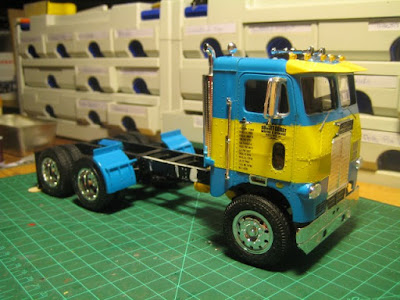Fresh from successful fabrication of door hinges on the Citroen H van, I decided to have a crack at hinges for the 40. Rather than individual barn door hinges, which are fragile and need to be lined up, I went for the admittedly inauthentic approach of a piano hinge, made from 1 mm brass tubing (0.225 mm wall thickness) with a 0.5 mm brass rod as the hinge.

Long story short: it took about three tries to get it right. In the end I cut two short pieces of tube, glued to the top and bottom of the door, and one longer piece in the middle glued to the jamb. Butting the round stock against a relatively flat surface is not exactly the best way to make a strong joint, and I attached small strips of flat styrene stock to each hinge section to increase the gluing surface area. The hinge rod in the pictures has not been trimmed, so the door can still be taken off for doing the interior and other things; I'll trim it flush only once it is all done.

With the door sorted out, I can now get this oddball LSR car back on track. It will sit next to a handful of other prewar racers of historic interest: Alfa Romeo 2900, Miller 91, Blower Bentley, Auto-Union Type C. Yes, a Type C!


The Auto-Union is from a resin kit maker I had never heard of before: Fernando Pinto is a Spaniard who makes obscure F1 and early '50's road cars. The Porsche-designed supercharged 6-litre V-16, in a mid-engine chassis, was way ahead of its time on paper, although the handling was reputed to be challenging. Lesser drivers were unable to handle the combination of power and oversteer; the cars were driven to wins by greats like Nuvolari and Rosemeyer. I am looking forward to seeing the kit and parking it next to HRM's Miller 91, with its 1.5 litre supercharged 8.
The kit includes some very nice wire wheels, and a couple of metal items (steering column, pushrod tubes) are molded directly into the resin. Otherwise it is the typical resin kit, with lots of flash to be removed.















































